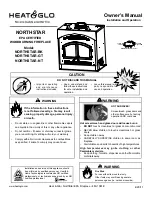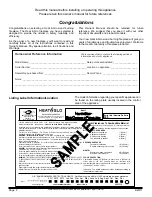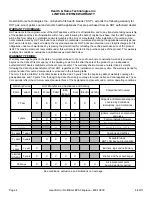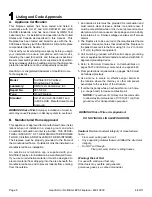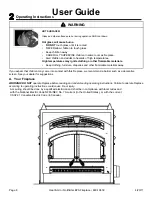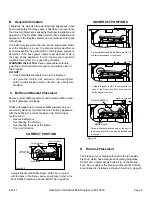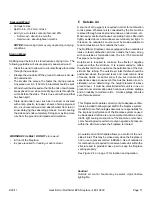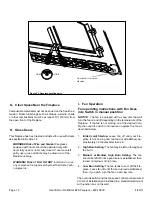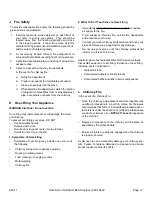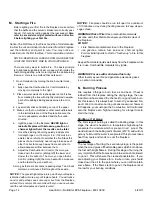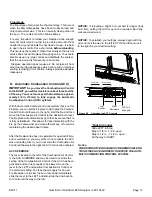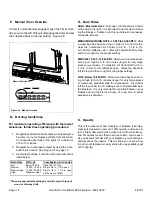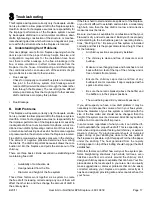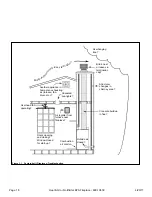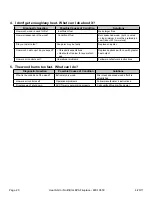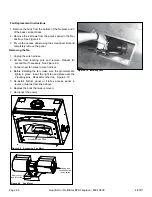
Page 14
4/20/11
Heat & Glo • NorthStar EPA Fireplace • 480-1081E
Before lighting your first fire in the fireplace, make certain
that the baffle and the ceramic blanket are correctly posi-
tioned. It should be resting against the rear support.
Also
refer to care and cleaning of plated surfaces on Section
5 before lighting your first fire.
Notice- The first three or four fires should be of moderate size
to allow the oils and binders to be burned from the fireplace
and the refractory and paint to cure. You may notice an
industrial odor the first few fires. This is considered normal.
NOTICE: REMOvE ALL LABELS FROM gLASS BEFORE
LIgHTINg THE FIRST FIRE IN YOUR APPLIANCE.
There are many ways to build a fire. The basic principle
is to light easily-ignitable tinder or paper, which ignites the
fast burning kindling, which in turn ignites the slow-burning
firewood. Here is one method that works well:
1. Open Outside Air by turning the knob counter clock-
wise.
2. Fully open the Combustion Air Control Handle by
moving it completely to the right.
3. Place serveral wads of crushed paper on the firebox
floor. Heating the flue with slightly crumpled newspa-
per before adding kindling keeps smoke to a mini-
mum.
4. Lay small dry sticks of kindling on top of the paper.
5. Make sure that no matches or other combustibles are
in the immediate area of the fireplace. Be sure the
room is adequately ventilated and the flue unob-
structed.
6. Light the paper in the fireplace.
NEVER light or
rekindle fireplace with kerosene, gasoline, or
charcoal lighter fluid; the results can be fatal.
7. Once the kindling is burning quickly, add several
full-length logs 3 in. (76mm) or 4 in. (102mm) in di-
ameter. Be careful not to smother the fire. Stack the
pieces of wood carefully; near enough to keep each
other hot, but far enough away from each other to
allow adequate air flow between them.
8. Adjust the Combustion Air Control; the more you
close down the control, (sliding left) the lower and
slower the fire will burn. The more you open the Air
Control, (sliding right) the more heat will be produced
and the faster the wood will burn.
As long as there are hot coals, repeating steps 7 and 8 will
maintain a continuous fire throughout the season.
NOTICE: The special high temperature paint that your fireplace
is finished with will cure as your fireplace heats. You will notice
an odor and perhaps see some vapor rise from the fireplace
surface; this is normal. We recommend that you open a window
until the odor dissipates and paint is cured.
M. Starting a Fire
NOTICE: Fireplace should be run full open for a minimum
of 30 minutes a day during heating season to keep air pas-
sages clean.
WARNING! Risk of Fire! Keep combustible materials,
gasoline and other flammable vapors and liquids clear of
the fireplace.
DO NOT:
• store flammable materials close to the fireplace
• use gasoline, lantern fuel, kerosene, charcoal lighter
fluid or similar liquids to start or “freshen up” a fire in this
fireplace.
Keep all flammable liquids well away from the fireplace while
it is in use. Combustible materials may ignite.
WARNING! For use with solid wood fuel only.
Other fuels may overfire and generate poisonous gases
(i.e. carbon monoxide).
N. Burning Process
Fire requires 3 things to burn: fuel, air and heat. If heat is
robbed from the fireplace during the drying stage, the new
load of wood has reduced the chances for a good clean burn.
For this reason, it is always best to burn dry, seasoned fire-
wood. We do not advise burning unseasoned wood, however
if it happens, you must open the Combustion Air Control and
burn the fireplace at a high burn setting for a longer time to
start it burning.
Kindling or 1st stage:
The first stage of burning is called the kindling stage. In this
stage, the wood is heated to a temperature highenough to
evaporate the moisture which is present in all wood. The
wood will reach the boiling point of water (212°F) and will not
get any hotter until the water is evaporated. This process takes
heat from coals and tends to cool the fireplace.
2nd stage:
The next stage of burning, the secondary stage, is the period
when the wood gives off flammable gases which burn above
the fuel with bright flames. During this stage of burning it is
very important that the flames be maintained and not allowed
to go out. This will ensure the cleanest possible fire. If you
are adjusting your fireplace for a low burn rate, you should
close down the air to the point where you can still maintain
some flame. If the flames tend to go out, the fireplace is set
too low for your burning conditions.

